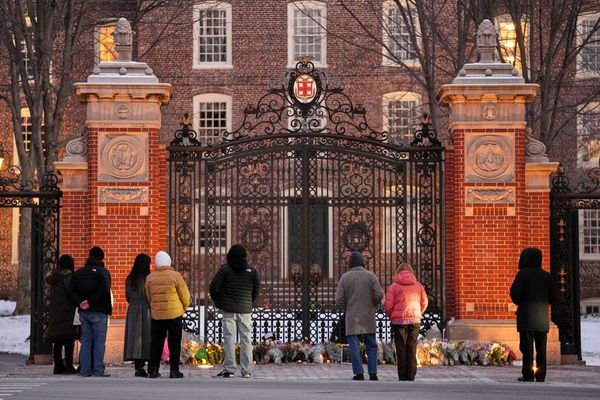Vance Martin’s first childhood memory was the sight of a woodpecker on a tree in front of his house when he was a year and a half old. “The next year, I looked out there and there was the woodpecker again. And I wondered if it was the same woodpecker,” says the 74-year-old, an expert in international nature conservation and wilderness protection.
Not surprisingly, Mr. Martin, who was in the city to speak at the Nature inFocus Festival, an annual festival to celebrate nature, conservation, and wildlife, always knew that he wanted to work with nature. “I turned down a full scholarship in sports to go to forestry school,” he says, adding, however, that he quit in a year and a half “because in the 60s if you were a forester, you were a tree farmer. That didn’t work for me,” says Mr. Martin. “I wanted something more holistic, but it didn’t exist back then.”
Instead, he studied English Victorian and Romantic Poetry. “I am so qualified to be in this field,” he says, with a guffaw, admitting that he was the poster child of the 60s back then with his long hair, regular use of marijuana, and strong belief in love and hope. “I draw on these (love and hope) every day of my life, even today,” says Mr. Martin, who left the U.S. at 21, a week after he got his degree because he didn’t like what was happening in the country back then. “This was Nixon, the Vietnam War,” he remembers. “I went away for six weeks and stayed away for 15 years,” he recalls.
Around this time, he met South African conservationist Ian Player, who became his mentor and worked closely with Player and his Zulu friend, Magqubu Ntombela, to establish the WILD Foundation. He went on to become its president in 1984, living in nearly 100 countries over the next three-odd decades, working on multiple projects aimed at sustaining the wild.
“Our flagship project was the World Wilderness Congress, a very unusual gathering that started in 1977,” says the septuagenarian, pointing out that these conferences have played a key role in strengthening wilderness policy globally. “The current one is being planned, but not by me since I have handed WILD over to another team,” says Mr. Martin, now the president of the Wilderness Foundation Global.
Talking about it, he says, “It isn’t an organisation—it is a group of friends working together to do the things we want to do, the things that need doing that don’t need organisational approval,” says Mr. Martin, adding he is entering a new phase of conservation work. “I am going to continue doing this, but in a different way. I have lots of petrol left in the tank,” he says. “It is entirely possible to heal the world if you focus on healing ourselves and our lack of relationship with nature.”

What are you most proud of having accomplished at WILD?
Well, there are some institutional things. There is the Global Environment Facility—GEF—which is an independent part of the World Bank. It is now the world’s largest funder of biodiversity projects and it started at the 4th World Wilderness Congress.
We also pioneered the very first inventory of wilderness around the world. This was in 1987—the pre-digital era. (It was) done on large-scale maps with rulers. And now that has been repeated several times and is an ongoing project for many groups, with remote sensing and everything. But it started back in the dark ages.
One of the other things that I am most proud of is that we gave a platform to traditional and indigenous people; one of our co-founders is Zulu. Indigenous people and the land they steward contain 80% of the remaining biodiversity on Earth. There have been a lot of problems between the conservation movement and indigenous people, but that doesn’t need to be the case. Conservation can and should be done with human rights, following the laws of UNDRIP (United Nations Declaration for the Rights of Indigenous People). Though conservationists and human rights are still fighting it out, progress has been made.
The other thing that we do that is a little more obscure—it is making culture an equal partner to science and economics and policy So, what is culture? It is what informs us who we are and how we want to live. That can be through art, language, the humanities, or music; anything that helps us get out of our heads a little. In our mind, it (conservation) is a four-legged stool: science, economics, policy, and culture. If you do not have those four legs, the stool is going to be a little wobbly and will fall over.
What do you think is the best way to handle human-animal conflict, ensuring that you conserve wildlife without negatively impacting local communities, who often live and eke out a living in protected areas?
Sometimes people need to move, and they must be incentivised to move. But they cannot just be pushed onto trucks. How you move them is the answer. And sometimes, we have had situations where people do not want to move. So, we let them stay there and make an agreement on a generational lease and they get compensated.
With the Peace Park Foundation in Africa, which I am involved in, we have just finished moving 2,000 families out of one park. It took 2.5 years to do the negotiations, and they left of their own will. They were compensated and got new land. It took a while because people take a while. You just must do it the right way.
As someone, who has been deeply involved in the Cheetah Conservation Fund, which has played a more significant role in the study and sustenance of the species in the wild, what are your thoughts about India’s cheetah reintroduction project?
I am not going to condemn it. I think it is a very worthwhile experiment that is not easy. There are all sorts of issues with it, including politics. But you know, the reintroduction of apex predators is a very uneven, unsettled science. If you don’t do it, you won’t learn more. Not everything succeeds. I think this has a chance of succeeding. I won’t put the odds on it—maybe 50/50—but it is a crucial experiment.
When they put wolves back into Yellowstone (in 1995. They had gotten extinct a hundred years ago) some people hated it. For instance, the hunting community hated it because it drastically reduced the number of elk, but suddenly the ecological processes began to happen again. The streams acted differently.
What is called riparian vegetation, the streamside bushes, came back. This brought back more small birds, etc. Ecosystem health improved tremendously, and the wolves exploded in population, more than they thought. They were doing so well that there were packs with two breeding females, something that has never been observed before.
It is not about whether it is good or bad. It was an experiment that needed to happen because it taught us about our relationship with the earth and how to have a better relationship with it. What we learn from it will benefit us and nature.







